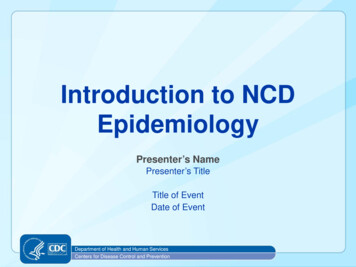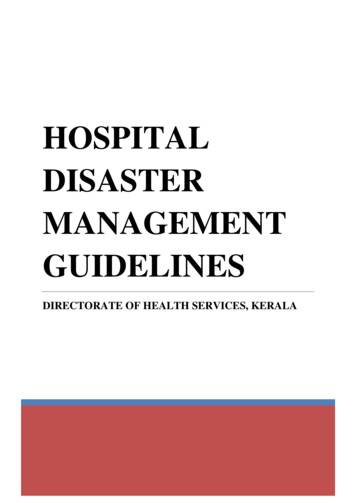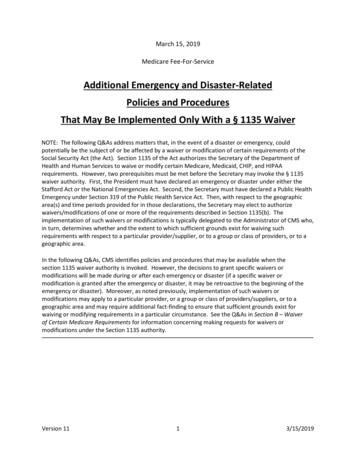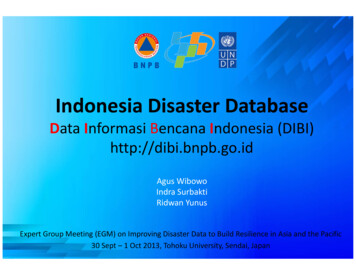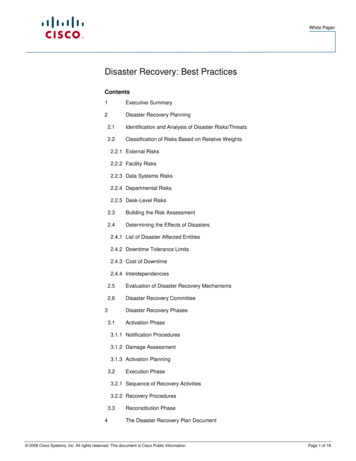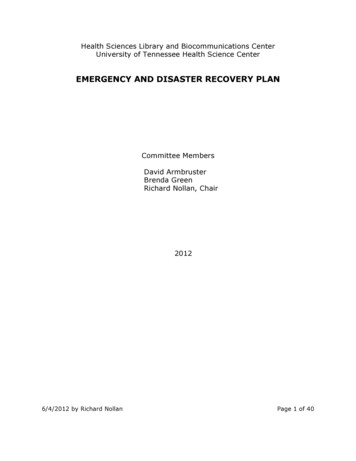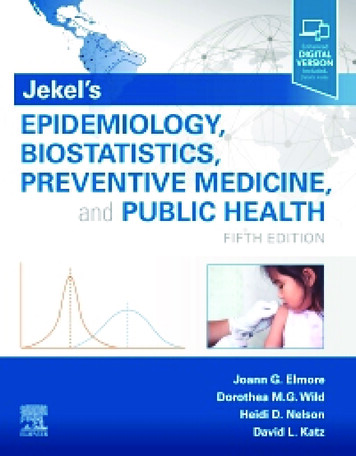
Transcription
27Disaster Epidemiologyand SurveillanceLinda C. DegutisCHAPTER OUTLINE1. Overview, 3841.1 Burden of Disaster, 3842. Definitions and Objectives in the Studyof Disasters, 3852.1 Descriptive Epidemiology, 3852.2 Analytic Epidemiology, 3852.3 Evaluative Epidemiology, 3863. Purpose of Disaster Epidemiology, 3863.1 Forensic Epidemiology, 3864. Disaster Surveillance, 3864.1 Syndromic Surveillance, 3874.2 Challenges in Disaster Surveillanceand Epidemiology, 3874.3 Designing a Disaster Surveillance System, 3875. Role of Government Agencies andNongovernmental Organizations, 3886. Summary, 389Review Questions, Answers, and Explanations, 389“We have had the lesson before us over and over again—nations that were not ready and unable to get ready foundthemselves overrun by the enemy.”of disaster epidemiology. Investigators use disaster epidemiology to assess the short-term and long-term health effects(both physical and mental) of disasters. In addition, disasterepidemiology is important in allowing epidemiologists andpublic health practitioners to understand how to preventdeaths, injuries, and disease spread in disaster situations.Despite advances in disaster epidemiology, however, there isstill a need to refine the approaches to surveillance andepidemiology in disaster situations.1Unlike in other types of events, when we perform epidemiologic studies and surveillance in disasters, we focus onnot only the inhabitants of a community affected by the disaster but also the workers and volunteers who respond to adisaster. These responders are often at risk for injury ordisease because of their involvement in the response (e.g.,a New York City Fire Department chaplain responding on9/11 was killed by a falling object). In other situations, workers may be exposed to infectious diseases or injury risks. Inaddition, while we routinely do not perform surveillance andepidemiology of the impact of disasters on communities andpopulations that are not directly affected by an event, theremay be both short-term and long-term impacts on bothnearby and distant communities and populations, some ofwhich may perceive risks similar to the people and communities affected by the disaster.Franklin D. Roosevelt1. OVERVIEWBefore discussing disaster epidemiology and surveillance, it isimportant to define what is meant by disaster. A disaster isgenerally considered to be an event that puts an overwhelming stress on a system such that the resources used on a dailybasis are inadequate for dealing with the impact of the event.The resources may be inadequate because of the number ofpeople affected by the event, or because the resources themselves have been damaged or limited as a result of the event.Disasters may be further categorized by intent or cause.Whereas natural disasters are events such as tsunamis, hurricanes, tornadoes, earthquakes, and floods, human-madedisasters are related to human-developed technology andmay be unintentional, such as a train crash, building collapse,or fire, or intentional, such as a terrorist attack, mass shooting, or the intentional distribution of a toxic agent (e.g., 1995sarin gas release in Tokyo subway, 2011 anthrax letters sent inUnited States, 2017 Las Vegas concert killings, 2018 Parkland,Florida school killings). In either case, the epidemiology andsurveillance needs in a disaster may be impacted by the typeof event that has occurred.Disaster epidemiology and surveillance are rooted in epidemiologic principles that apply to other diseases, but uniquechallenges and concerns need to be considered in the context3841.1 BURDEN OF DISASTERThe World Health Organization (WHO) estimates that2.6 billion people have been affected by natural disaster phenomena in the past decade.2 In the United States, there has
CHAPTER 27been a steady increase in the number of official disaster“declarations” with more than 100 declarations in 2017. TheGlobal Disaster Alert and Coordination System (GDACS)provides real-time information on disaster alerts around theglobe and includes maps and other information about typesof disasters that are current or past.32. D EFINITIONS AND OBJECTIVESIN THE STUDY OF DISASTERSTo have a basis for understanding the issues associated withdisaster epidemiology and surveillance, it is important tounderstand the definitions commonly used in the study ofdisasters. First, a disaster could be considered an event thatplaces a strain on the health or public health system such thatadditional resources are needed to respond. Disasters mayoccur within an institution, in a community, or on a broaderscale. Disasters can be classified in a number of ways, but areusually described as natural or human-made, as previouslynoted. Natural disasters encompass a range of situations thatput people at risk for significant health effects.Disaster epidemiology is defined as the use of epidemiology to assess the short-term and long-term adverse health effects of disasters and to predict and prevent consequences offuture disasters. It brings together various topic areas of epidemiology, including acute and communicable disease, environmental health, occupational health, chronic disease, injury,mental health, and behavioral health. Disaster epidemiologyprovides situational awareness—that is, it provides information that helps responders understand what the needs are,plan the response, and gather the appropriate resources.The main objectives of disaster epidemiology are as follows: Prevent or reduce the number of deaths, illnesses, andinjuries caused by disasters Provide timely and accurate health information for decision makers Improve prevention and mitigation strategies for futuredisasters by collecting information for future responsepreparationAs with other types of epidemiology, disaster epidemiology focuses on identifying disease and injury patterns andrisk factors to the population and community affected by thedisaster. This information serves as the basis for developingprevention and mitigation strategies that are driven by threecontexts of disasters: time, place, and person. For example,hurricane season on the US East Coast, as well as in theCaribbean, is June 1 through November 30, whereas the Eastern Pacific season runs from May 15 to November 30.4 Inaddition, the geographic area generally at risk is defined. Although people who live on or near the coast are at increasedrisk of injury or death during a hurricane, evacuation fromthe hurricane zone minimizes or eliminates this risk.In contrast to the disaster epidemiology of hurricanes, theusual season for flu occurrence is over the late fall and wintermonths in the United States. Flu risk is related to exposure,immunization status, and other factors such as age; generally,Disaster Epidemiology and Surveillance385elderly and very young populations, people with chronic illness or immunocompromised, and pregnant women are atincreased risks for complications and mortality, dependingon the flu strain that is active in a given year.5 Preventionstrategies would focus on prioritizing immunization of highest risk populations but incorporating immunization strategies to cover as much of the population as possible, anddepending on the severity of an outbreak, isolation and possible medical treatment of people who have contracted flu orwho have been exposed and are likely to expose others to risk.In a disaster situation, three types of epidemiology generally are used: descriptive, analytic, and evaluative. Each contributes to the understanding of the disaster event, as well asthe prevention and mitigation of harm of future events.2.1 DESCRIPTIVE EPIDEMIOLOGYEpidemiologists use descriptive epidemiology to identify thedistribution of disease or injury among the populationgroups affected by the disaster. This includes identifyingthe health-related issues that occur among people who areresponding to the event.After the 9/11 World Trade Center disaster, responders tothe scene were exposed to various types of particulate matter,as well as larger pieces of debris, some of which fell from thecollapsing towers. Other responders complained of resultingrespiratory problems. The epidemiology of the health aftermath of the disaster continues to emerge; longitudinal surveysare providing information on various health outcomes. Astudy of 2960 nonrescue disaster workers deployed to theWorld Trade Center following 9/11 found that at 6 years afterthe event, 4.2% still exhibited symptoms of posttraumaticstress disorder (PTSD). Risk factors for ongoing PTSD included major depressive disorder 1 to 2 years after the event,history of trauma, and extent of occupational exposure.6Asthma rates are increased in the 9/11 disaster responders aswell, with a lifetime prevalence 6 years later that was almosttwice (19% vs 10%) that of the general population.7 On alarger scale, the World Trade Center Health Registry at theNew York City Department of Health and Mental Hygienewill provide a 20-year follow-up through periodic contactwith the enrollees.8 To date, several research studies have provided information about the long-term effects of the disaster,including hospitalizations for asthma,9 heart disease and lungdisease,10 parent physical and mental health,11 among othertopics.12 This large disaster registry is continuing to provideinformation that may be helpful in planning prevention andintervention strategies (Box 27.1). The development ofregistries to monitor long-term effects of disasters has notbeen generalized to all disaster events but has the potential toinform efforts at prevention and mitigation strategies.2.2 ANALYTIC EPIDEMIOLOGYAnalytic epidemiology can provide information about differences between people who were injured or became ill duringan event and those who did not. The benefit is that analytic
386SECTION 4Public HealthBOX 27.1 World Trade Center HealthRegistry ProjectsThe current survey includes over 36,000 respondents as ofOctober 2016 and is split between survivors (.37,000) andresponders (.29,000). Through the overall survey and specialsurveys, the registry is being used to investigate the following: Cardiovascular disease Skin rash Alcohol use Posttraumatic stress disorder (PTSD) among police Unmet mental health care needs Cancer rates among enrollees Health of Staten Island landfill and barge recovery workers Respiratory and behavioral health of children Impact of 9/11 injuries on long-term enrollee health Coexistence, or comorbidity, of respiratory and mentalhealth conditions experienced by many enrolleesData from New York City Department of Health and Mental Hygiene,World Trade Center Registry, Survey response rate: f/wtc/wtc-datafile-manual15.pdf.epidemiology gives information about the risk and protective factors related to a disaster event. For example, an investigation of deaths and injuries after a tornado outbreak canprovide data about where people were when they were killedor injured, the types of injuries sustained, and whether protective factors had an impact on the occurrence of injuries.These may be environmental or behavioral factors. This typeof study allows informed recommendations for interventionsto help protect people from injury caused by tornadoes. It iseasy to imagine how information about and descriptions ofrisk and protective factors in disaster events can be useful topreparedness and response planners.2.3 EVALUATIVE EPIDEMIOLOGYIn using evaluative epidemiology, investigators can determinethe effectiveness of specific interventions that have been implemented and identify factors that have resulted in theirsuccess or failure. It allows them to modify strategies anddevelop new interventions. This allows epidemiologists todetermine, for example, if specific immunization strategiesare effective in preventing spread of flu, or whether environmental changes (e.g., building standards) are effective in decreasing building collapses, and therefore deaths and injuries,in earthquakes.Consider the example of mass shooting in schools in theUnited States (e.g., Parkland, Florida, in February 2018). Therehave been numerous suggestions about how to prevent similarincidents, ranging from arming teachers or placing armedguards in all schools, to continuing to hold active shooter drillsto prepare school children for possible events. Evaluative epidemiology can provide information about the use of these interventions, as well as the risk and protective factors associatedwith them if an event occurs. Evaluative epidemiology may addto the data needed for research across events in addition toresearch related to a specific event.3. PURPOSE OF DISASTER EPIDEMIOLOGYDisaster epidemiology allows investigators to identify thepriority health problems in the community affected by adisaster. Although the primary focus is on health problemsrelated to the disaster itself, epidemiologists can also learnabout preexisting health problems that impact a community’s resilience and create needs for specific services during adisaster. In a disaster or public health emergency, it is alsoimportant to identify the causes of disease and injury andassociated risk factors in the context of the event. This mayinclude examining the results of laboratory testing of biologic and other specimens to identify specific disease agentsor toxic substances involved in the event.Various methods of classifying severity of injury or illnesscan aid in determining priorities for health interventions.The epidemiologic assessment of health problems allows fora rapid needs assessment that leads to planning for interventions, identification of the need for additional help, andmodifications as well as additional support for the infrastructure. As an event evolves, continued surveillance and epidemiology allow tracking of the course of diseases, as well asidentification of emerging issues. For example, althoughmany people were killed and injured in the 7.0 earthquake inHaiti on January 12, 2010, it took several days to identify theemergence of cholera, which presented a significant risk tothe survivors. Epidemiology was used to identify cases andlimit the spread of the disease. In January 2011 the PanAmerican Health Organization13 released a report on thehealth impact of the earthquake, highlighting lessons thatcould be applied to the next major disaster event. In this way,the epidemiology and surveillance from one disaster can beused to inform planning and response for future events.3.1 FORENSIC EPIDEMIOLOGYForensic epidemiology is not discussed as often as it might bewith respect to disaster epidemiology. The field of forensicepidemiology brings together public health and a legalinvestigative approach to examining a disaster or emergencysituation. This is especially important in cases of suspectedbioterrorism and other intentionally created events. Forensicepidemiology explores the intent, persons involved, degree ofharm, and risk factors, to form a complete picture of an intentional disaster. As an example, the 1985 investigation ofintentional contamination of salad bars in Oregon led to theprosecution of the religious group responsible.14 In the caseof mass shootings, a forensic epidemiology approach canprovide critical information to identifying commonalitiesand differences between the mass shooting events.4. DISASTER SURVEILLANCEAs with other parts of epidemiologic practice, surveillanceplays a critical role in epidemiologic investigations duringand after a disaster. One of the major challenges of surveillance in disasters is that many routine surveillance systemsmay not provide the information necessary to assess needs or
CHAPTER 27identify disease or injury patterns. This occurs in both natural and human-made disasters and creates difficulty for alltypes of disaster epidemiology. Disasters present special circumstances in which surveillance may be difficult, and during which routine surveillance systems may not be functionalor accessible because of the circumstances of the disaster. Astechnologies continue to emerge, the potential for using newdata collection systems can increase our ability to initiate andmaintain surveillance systems early in the course of a disaster.4.1 SYNDROMIC SURVEILLANCESyndromic surveillance uses indicators of population and individual health that may appear before widespread disease isconfirmed through clinical or laboratory diagnosis. This type ofsurveillance is often set up as a routine surveillance mechanismthat is in place to monitor for specific diseases. For example, asharp increase in sales of over-the-counter cold remedies mightindicate the emergence of a new respiratory virus. Across theUnited States, emergency departments participate in syndromicsurveillance systems designed to detect clusters of events in theearly phases of an outbreak, such as gastrointestinal illnesscaused by food poisoning or disaster. Syndromic surveillancesystems may be based on existing data systems, particularlywhen electronic health records are available in real time. If thefocus is looking for a specific disease, case criteria for surveillance are identified, whereas in a more general syndromic surveillance strategy, data may be monitored for unusual patternsthat could indicate emerging disease. The Centers for DiseaseControl and Prevention (CDC) has developed definitions fordiseases associated with critical bioterrorism agents.15 In addition, syndromic surveillance may be implemented on a shortterm basis during specific events when there is a possibility ofeither disease transmission or an intentional act that results inillness. For example, during the 2002 Kentucky Derby Festival,12 hospitals successfully participated in the surveillance systemthat was set up to quickly interpret emergency department patients’ chief complaints to serve as a disease sentinel for thecommunity.16 Syndromic surveillance is being integrated intopractice in health care settings, and entire countries are nowusing this approach. The CDC has established a committee,Syndromic Surveillance and Public Health EmergencyPreparedness, Response and Recovery (SPHERR), that helpsintegrate syndromic surveillance data and information intopreparedness and emergency response.174.2 C HALLENGES IN DISASTERSURVEILLANCE AND EPIDEMIOLOGYTo perform disaster surveillance activities, it is important topredefine the variables and data points that would be of interestduring a particular type of disaster. Although a core set of variables is important in any disaster event, each type of event hasunique circumstances that need to be documented to understand fully the impact of the event. For example, the spread of anewly emerging strain of flu would necessitate identification ofthe strain causing infections in the population of interest,at least to the extent that one can assume the cases beyond aDisaster Epidemiology and Surveillance387certain point in time could be attributable to the agent that hasalready been identified. In the case of a tornado or earthquake,the specific location of victims, with details about the type ofbuilding, the force of the tornado or earthquake, the injuriessustained and their severity, and the outcome for each personinjured are all important data to collect. In an infectious diseaseoutbreak, the trajectory of the impact on the population is verydifferent, and there may be more time to collect data to plan forthe resources and interventions that will be needed. These aredata points in addition to demographic data.Surveillance is also important after the disaster, particularly if there are risks for the development and increasedtransmission of infectious diseases due to the nature of theevent or other known or potential long-term health impacts.Events that disrupt water supplies and sanitation place thecommunities affected at risk for the spread of infectious disease from contaminated water sources. Other postdisasteroutcomes of interest include recovery status of injured disaster victims. An understanding of the severity of injuries sustained, as well as long-term rehabilitation and support needs,will aid in community planning.4.3 D ESIGNING A DISASTERSURVEILLANCE SYSTEMAs much as possible, a disaster surveillance system should notrequire a large amount of additional resources or personnel during a disaster event. Because personnel will be consumed withresponding to the disaster and implementing interventions, requirements for collecting large amounts of additional data arelikely to create difficulties for the personnel involved. The number of skilled staff may be insufficient to collect the data needed,or the staff responding may not have a good understanding ofbasic epidemiologic principles and measurement. There may belimited access to the population of interest. If a sample of thepopulation is surveyed, it may not be representative of the overall population affected by the disaster. Cultural and languagebarriers pose additional problems, along with the difficulty ininvestigating the long-term needs of the affected population.A core set of data points can be used in surveillance inmost disaster events. Demographic data as well as simpleoutcome data for both victims and responders are useful intracking the impact of the disaster as well as identifying theneed for resources. A data system design that allows for amodular approach, which adapts the data to be collected depending on the type of event as well as the phase of the event,may be useful. System design requires consideration of thedata collection methods that are routinely available and thatmay be available after the disaster. In addition, it is importantto consider the burden that data collection will present to analready-stressed system. When possible, it is important to useexisting data systems rather than creating new systems thathave not been tested or accepted by those involved in a disaster response; the simpler the data collection, the better. It isalso possible to collect postdisaster data and interview peoplewho were at the scene, but this is not always optimal becauseof the potential for recall bias and for data to be missing frompatient records. Data collection during and after a disaster
388SECTION 4Public Healthmust take into account existing data sets and information;the size, demographics, and baseline health status of thepopulation affected; and available resources. Geographicmapping can be useful in examining the impact of environmental factors in a disaster. Consideration should be given tocollecting data that will be, or are likely to be, used.When there is an urgent need for information or acquisition of resources, a rapid survey may be done. In this scenario, only the minimum information necessary to meet thesurveillance goals is collected. Only information that is notalready available or cannot be collected in another way isobtained, and the goal becomes to collect as representative asample as possible to ensure generalizability to the population affected. This type of survey is sometimes repeated andrefined over the course of the event and postevent period.In the postdisaster period, surveys of persons who were pre sent during the event may be helpful, as may surveys of those whowere injured or who became ill during the event. Key informantinterviews can provide information about risks and mitigatingfactors experienced in the community and can help identify approaches to planning for future events. As previously described,longitudinal surveys of survivors and responders provide information about long-term health and social impacts.5. R OLE OF GOVERNMENT AGENCIES ANDNONGOVERNMENTAL ORGANIZATIONSPreparedness for and response to disasters and pandemicsrequire a coordinated effort from multiple agencies andorganizations. Although an in-depth discussion is beyondAssessmentVisioningPre-DisasteraEngage publicCommunity healthneeds assessmentHazard vulnerabilityassessmentPlanningDetermine roles& authoritiesImplementationLearning cycleAssemble multisectoral stakeholdersPost-DisasterHealthy, Resilient,SustainableCommunity VisionDefined goals andprioritiesImpactassessmentOrganizational& governancestructuresHealth improvementplanningHealthimprovement planCommunitystrategic planningComprehensiveplanPost-disasterrecovery planningPre-disasterrecovery planningPre-disasterrecovery planRecovery planSeek & applyresourcesSeek & applyresourcesSet benchmarksSet benchmarksHealthier & moreresilient & sustainablecommunitiesRECOVERYa Although the committee strongly encourages communities to undertake these activities in the pre-disaster period to maximizethe opportunities to leverage the post-event recovery process for the purpose of creating healthier, more resilient and sustainablecommunities, in the event that they have not been undertaken beforehand, there is still benefit to incorporating them intopost-disaster recovery planning.Fig. 27.1 Building healthy, resilient, and sustainable communities before and after disasters. (From NationalAcademies: -Brief-Insert.pdf
CHAPTER 27the scope of this chapter, a brief summary of the role offederal agencies and nongovernmental organizations(NGOs) is helpful in understanding the multifaceted natureof preparedness and response.Public health focuses on overall population health andensuring that population-based measures are in place fordisaster preparedness and response. Surveillance activities arein the realm of public health, as is disease reporting and investigation of disease and injury occurrence. Emergencymanagement agencies, which exist at various governmentallevels, focus on the overall management of a disaster responseand coordination of recovery services, and may be responsible for allocation of resources. The US Federal EmergencyManagement Agency (FEMA), now in the Department ofHomeland Security, works to plan for disasters and terrorism,makes recommendations to the public on how to prepare forevents, provides education for responders, and reviews disaster declaration requests from governors to ensure that resources are appropriately allocated and distributed.18Various other agencies are involved in preparing for andresponding to disasters at the local, state, and federal levels. Theprivate sector and NGOs, such as the American Red Cross,19have an important role as well, providing services such as shelter, food, and clothing. NGOs also respond to disasters thatoccur around the world, providing emergency and long-termshelter, health care, food, clothing, and other services.6. SUMMARYDisaster epidemiology and surveillance are critical components of a disaster response and can contribute to understanding the nature of an event as well as the implications forplanning for future events. There are unique challenges presented in performing surveillance during disasters, but theefforts made at surveillance using epidemiology principlesprovide valuable contributions to our understanding of disasters and planning for future events. Efforts to build healthy,resilient and sustainable communities after disasters can beaddressed both predisaster and postdisaster (Fig. 27.1).Disaster Epidemiology and Surveillance3897. Kim H, Herbert R, Landrigan P, et al. Increased rates of asthmaamong World Trade Center disaster responders. Am J Ind Med.2012;55:44-53.8. New York City Department of Health and Mental Hygiene. 9/11Health, WTC Health Registry. Available at: h-registry.page.9. Miller-Archie SA, Jordan HT, Alper H, et al. Hospitalizationsfor asthma among adults exposed to the September 11, 2001World Trade Center terrorist attack. J Asthma. 2018;55(4):354-363.10. Alper HE, Yu S, Stellman SD, Brackbill RM. Injury, intense dustexposure, and chronic disease among survivors of the WorldTrade Center terrorist attacks of September 11, 2001. Inj Epidemiol. 2017;4:17.11. Gargano L, Locke S, Brackbill RM. Parent physical and mentalhealth comorbidity and adolescent behavior. Int J Emerg MentHealth. 2017;19:358-365.12. New York City Government. NYC 911 Health. Available /publishedresearch-publications.page.13. Pan American Health Organization. Health Response to TheEarthquake in Haiti: January 2010. Washington, DC: PAHO;2011.14. Török TJ, Tauxe RV, Wise PR, et al. A large community outbreakof salmonellosis caused by intentional contamination of restaurant salad bars. JAMA. 1997;278:389-395.15. Centers for Disease Control and Prevention. SyndromeDefinitions for Diseases Associated With Critical BioterrorismAssociated Agents. Available at: .htm.16. Carrico R, Goss L. Syndromic surveillance: hospital emergencydepartment participation during the Kentucky Derby Festival.Disaster Manage Response. 2005;3:73-79.17. Centers for Disease Control and Prevention. Syndromic Surveillance and Public Health Emergency Preparedness Response andRecovery Committee (SPHERR). Available at: lic-Health-EmergencyPreparation-Group.htm.18. Federal Emergency Management Agency. FEMA’s Role in WinterWeather. Available at: nter-weather.19. American Red Cross. Available at: https://www.redcross.org.REFERENCES1. Noji EK. Disaster epidemiology: challenges for public healthaction. J Public Health Policy. 1992;13:332-340.2. World Health Organization. Emergency and Essential SurgicalCare. Available at: http://www.who.int/surgery/challenges/esc disasters emergencies/en/.3. Global Disaster Alert and Coordination System. Available at:http://www.gdacs.org.4. National Oceanographic and Atmospheric Administration: NationalHurricane Center. Available at: https://www.nhc.noaa.gov/climo/.5. Centers for Disease Control and Prevention. People at High Riskof Developing Flu-Related Complication. Available at: https://www.cdc.gov
sarin gas release in Tokyo subway, 2011 anthrax letters sent in United States, 2017 Las Vegas concert killings, 2018 Parkland, Florida school killings). In either case, the epidemiology and surveillance needs in a disaster may be impacted by the type of event that has occurred. Disaster epidemiology and surveillance are rooted in epi-
